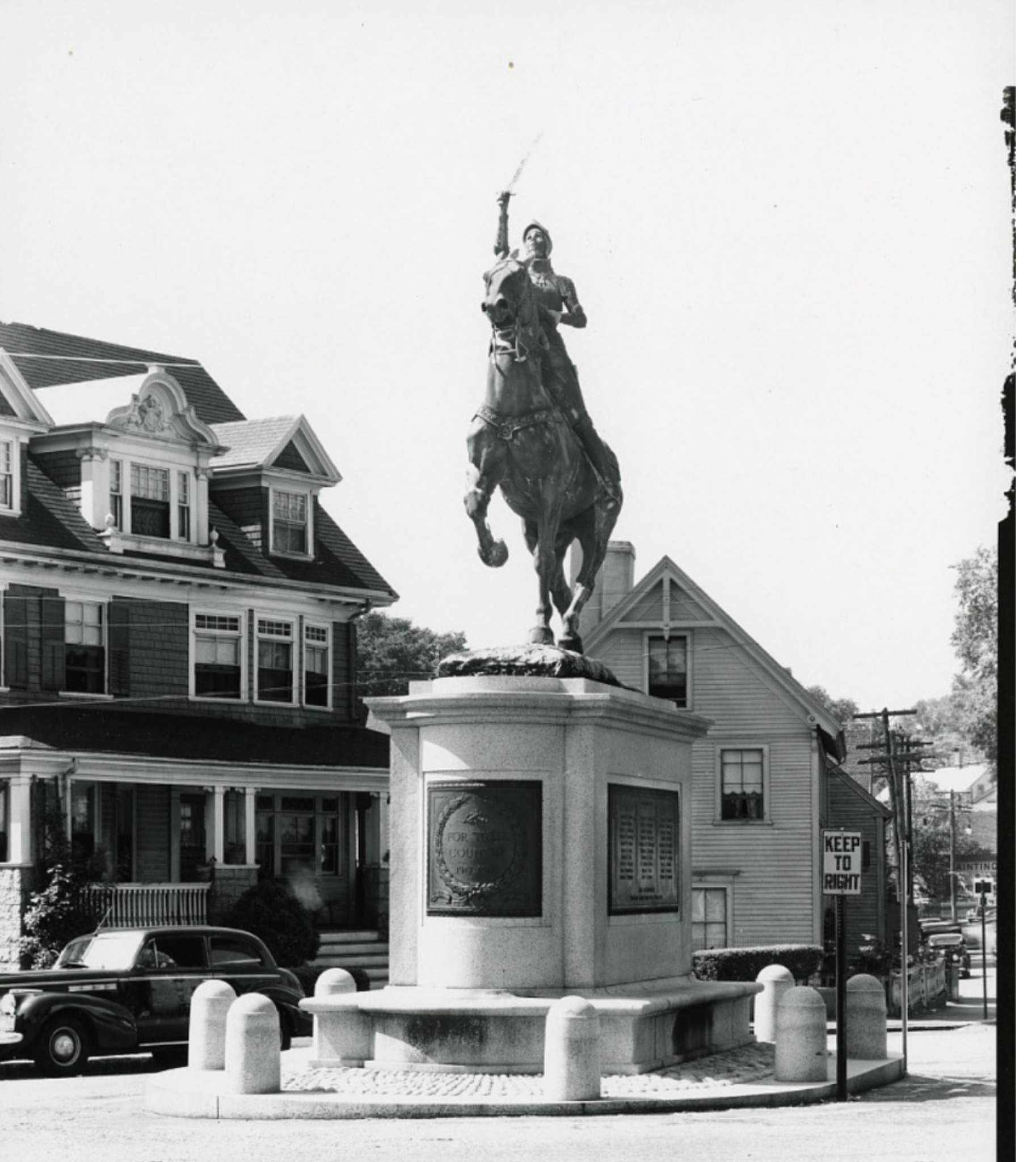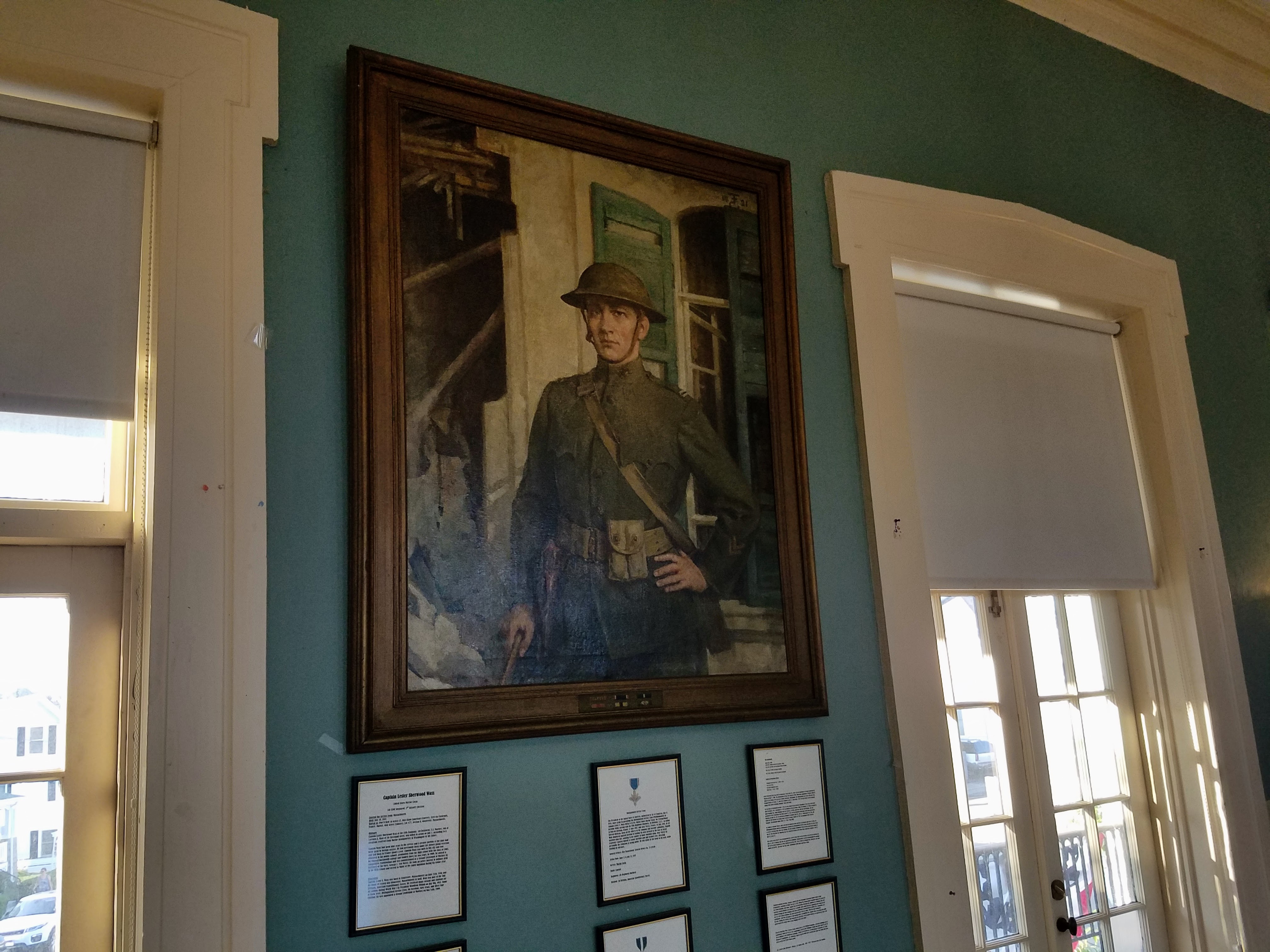1921
“The first day’s ceremonies in connection with the dedication of the American Legion memorial building, in Old Town Hall Square and the dedication of the base on which will stand a replica of Anna Vaughn Hyatt’s statue of Joan of Arc, were of an impressive nature.
To dream the impossible dream.
A feature of the day was an address by Major Gen. Clarence R. Edwards in which he characterized peace by disarmament an impossible dream.
Speaking this evening from the balcony of the new Legion Building, Gen. Edwards said that the importance of the National defense in the World War was realized more deeply than ever, and that Cape Ann played a major part with other important strategic points. Alluding to pacifist propaganda, he characterized the realization of peace by disarmament as an impossible dream. Place two children 9 months old together and a toy between them, he said, and a struggle ensues. This basic principle is ingrained in every person and animal. Alluding to Americanism, immigration and melting pot problems, he said that the association of the youth of the immigrant with those of native stock will settle those questions.
“Why,” he said, “a foreign born youth who will face a nest of machine guns in the defense of this country is a good enough American for me.” He referred to the case of Sergt. Casagranda of Bay View, a suburb of this city. Twenty of his comrades petitioned for his advancement over them to rank of sergeant.
A regrettable incident of the day was an accident to Vice Commander Eugene Lord of the local Legion post. He drove an auto against a rope across a street that was barred off. The glass of the windshield was broken, cutting him across the face and destroying the sight of an eye.
Services in the Morning.
The Legion Post attended services at the Independent Christian Universalist Church this morning. A special program had been arranged by Prof. George B. Stevens, the organist of the church.
As the Legion filed down the elm shaded churchyard, the bugler played “The Marsellaise.” This theme was taken up on the organ as the Legion filed into the church.
The pastor, Rev. Dr. John Clarence Lee, preached. Dr. Lee reminded his auditors that the first pastor of the church. Rev. John Murray, was commissioned a chaplain by Gen. George Washington.
Capt. Lester S. Wass, for whom the Legion Post is named, was an attendant at the church. He pleaded for justice to disabled and needy war veterans.
Names on Tablets.
The exercises tonight at the dedication of the base of the monument were deeply impressive. Owing to causes beyond the Legion post’s control the statue could not be delivered in time for the dedication. The Cape Ann granite base, designed by Frederick G. Hall, a Boston artist, a summer resident of East Gloucester, had been placed in position with the bronze tablets bearing the names of the 57 youths who went from Gloucester to the World War never to return. The base was draped with the Stars and Stripes. At each corner of the base was a column. On each of these four columns, in black and white, were Romanesque braziers. These braziers were lighted, also four incense urns. The faces of the thousands who stood with bared heads were illuminated.
All sensed the solemnity of the moment.
Battery Fires Salute.
A battery fired 57 rounds for the boys* who did not return from war. At the same time all the church bells in the city tolled.
The speaking took place from a balcony in the Legion building. Mayor Wheeler made a short address, followed by Maj. Gen. Clarence R. Edwards of the 26th Division. He was followed by Col. A. Piatt Andrew, commander of the Legion post. Then the concourse sang “America”.
Prayer was offered by Rev. William J. Dwyer, PR. Of St. Ann’s Catholic Church, Rev. Dr. A.A. Madsen of Trinity Congregational Church and Rabbi J. Steinberg of the Jewish Synagogue.
The tablets were unveiled by Miss Abby F. Rust, a squad firing a funeral volley and “Taps” being sounded.
Council’s tribute.
The mothers and fathers and near relatives of the dead were then escorted forward, each placing a wreath of palm on the base of the monument. Mayor Wheeler and the city council then performed the same rite on behalf of the city.
The vested choir of St. Ann’s now sang the Gregorian chant, followed by the vested choir of St. John’s Episcopal Church singing ‘The Son of God Goes Forth to War”.
Representatives of the churches deposited their floral tributes. The great crowd of 10,000 persons, a great many of whom deposited floral tributes, filed reverently away. The enclosure was literally buried with flowers. In this ceremony delegations from the Mine Laying fleet, the G.A.R. Spanish War Veterans, Red Cross and all the civic and secret organizations of the city were represented.
Legion Hall Dedicated.
Preceding the dedication of the base was the dedication of the legion hall, the old Town Hall of Colonial design, restored and enlarged, with the unveiling of an oil painting of Capt. Lester S. Wass of this city, who lost his life in the Argonne while leading a company of marines. The painting is the contribution of Eben F. Comins, a Boston artist and summer resident of Eastern Point.
The address was by Maj. James T. Duane, State commander of the American Legion. Mr. Comins presented the picture to the post and the unveiling was by Miss Elizabeth Wass Foster, a niece of Captain Wass.
The prayer and benediction was by Rev. Bertram D. Bolvin, ex-chaplain of the 15th Infantry, State Guard, and minister of the First Parish Unitarian Church of this city.
In order that Gen. and Mrs. Edwards might be present, Capt. Lackey of the U.SS San Francisco, flagship of the Mine Fleet, detailed a destroyer to go to Plymouth to bring them over.”
“Disarmament Dream, Edwards Speaks to Thousands at Gloucester Memorials to the City’s War Dead. Dedicated official of Legion Post loses eye in accident during the event. Special Dispatch to the Globe.” Boston Globe, July 3, 1921




photo credit above: interior c. ryan 2017 (installation view of Eben Comins portrait of marine Capt. Lester S. Wass. The artist gifted the painting as part of the Legion Post dedication in 1921. Legion Post Honor books to the left.) Exterior: Smithsonian collection (b&wh); c. ryan 2016
photo credit below: c. ryan, 2016 / reprint by Fred Bodin of historic photo (Town Hall before architectural additions)













